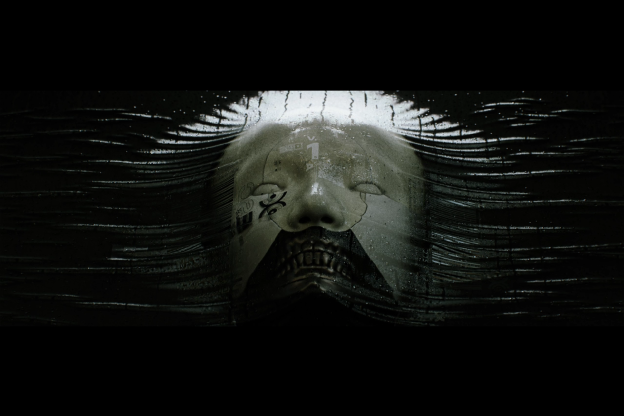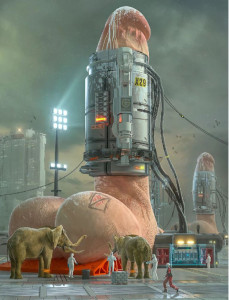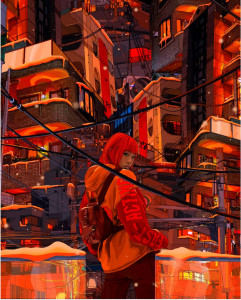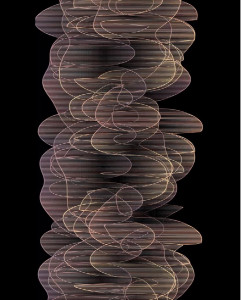Fingerprints DAO
Curator Sam Spike discusses what it means for an NFT smart contract to be an artistic medium.

Venture capitalist Ryan Zurrer invests in a range of forward-looking initiatives, from renewable energy to psychedelics to web3 gaming. He made headlines last year when he purchased Beeple’s first sculpture, Human One, for 29 million USD at Christie’s. The acquisition marked a new phase in Zurrer’s ongoing commitment to digital art. The collector spoke to Outland about some of his favorite works, as well as his initiatives to support art in the web3 space.
Digital art is starting to be accepted as legitimate because of the scarcity and rarity enabled by the cryptographic primitive of NFTs. I got excited by the rags-to-riches stories of digital artists who previously had to maintain other jobs outside their art practice in order to pay the bills. After a decade in crypto, it’s probably the most inspiring story I’ve heard. As I spend more time interfacing with people in the traditional art world, I find it inexplicable that digital artists have not had adequate representation in the canon. NFTs will be a catalyst for the recognition these artists deserve.

The evolution of my relationship with Beeple as a collector is emblematic of my relationships with these artists more broadly. After I bought The Dick Milking Factory (2021), we got on a call and hit it off. When Human One (2021) came up for auction, I purchased it in part as an investment in my relationship with Beeple over the next thirty years. I’m committed to putting that work in museums around the world instead of just having it at home.
What I’ve learned as a venture capitalist is that the most important resources you put into a project are not financial resources, but the time and sweat and the effort that come after the investment. That’s the approach we’ve taken with Human One. We have a team working on the complexities of shipping it around the world. Then there’s the issue of where digital custody ends and physical custody begins. These are the unanswered questions that we’re working to solve.
Another work that remains in my personal collection is Bag of Oranges (2021) by Mad Dog Jones. It’s my online identity in a lot of social forums. The artist and I have become really good friends, too. He is the defining Canadian artist of his generation.

The work I wanted to do on behalf of artists got beyond the scope of what I could do on an ad-hoc basis. I want my collection, like any capital pool that I’m involved with, to be run professionally. I founded the collectors’ club 1of1 to manage these issues, and transferred some of my works to this association. I wasn’t happy with other collector DAOs I’ve participated in. I didn’t like that one person could show up and be the loudest voice even if they’d only bought one share. I didn’t like that the people operating the DAOs are usually unpaid. A collection should be managed by professionals who can make sound decisions and are appropriately remunerated.
We’ve diversified the 1of1 collection to include what we call the metaverse assets, like Axie Infinity assets and CryptoPunks. These are managed by data scientists who can evaluate that type of collection, instead of the art experts who make decisions about the art collection. While we wanted to have some shared synergies, we also wanted mutual exclusivity. If you look out across the collector pool landscape, whether it’s funds or DAOs, collectibles and artworks are often held together, without nuance and elegance.
I would consider myself a technolibertarian utopian. I believe that technology will solve many of the problems that we face today. Consumption and its impact on global warming have mostly been solved in technological terms. It’s just a matter of implementing the infrastructure, which will take a few decades. The biggest problem that mankind faces is mental health. Thalamic Pulse (2022) by IX Shells looks like psilocybin growing on a tree. IX Shells has been an incredible inspiration, in particular for the recent auction of works we organized for the Multidisciplinary Association for Psychedelic Studies (MAPS) in collaboration with Christie’s. She shared with me how a psychedelic therapeutic using the MAPS protocol saved her life, right before the sale of her work Dreaming at Dusk (2021) made her one of the highest-selling women artists in any category. She’s an unquestioned leader in the space. Hers is a remarkable story, and it reminds us how important these therapies can be. When I reached out to other artists after deciding to do the auction, it was mind-blowing how many people came back with similar stories of how psychedelics changed their lives.

I have a thesis I call “proof of artwork.” It’s based on the concept of proof of work, which is the sum value of a crypto network—all the capital and operating expenditures that go into securing a ledger. The baseline value of Bitcoin is about 150 billion USD—the funds spent on all the machines and electricity and time and effort. With art, I often find myself asking about the resources that have gone into the making of a work. This line of thinking leads me to pieces like the Artificial Organisms series (2021) by Maxim Zhestkov, which involves an incredible amount of computation. Ash Thorp is artist who will spend an order of magnitude more on computation to achieve the slightest variation in aesthetics. To get the refraction of light on the beads of sweat in Product Placement (2022), he had to redo the rendering. The result was far more complex than it otherwise would have been. Ash’s work often invokes this somewhat melancholy parallel reality that could have been, and still could be—a dystopian possibility of what we need to be on guard against.
I’m trying to use some of the heuristics of traditional art collecting, which I’m learning from mentors that I’ve brought along on this journey with me, like Jehan Chu and Hans Ulrich Obrist. The emotion a work evokes is important to collectors. I’ve built a portfolio of very complex, technically sophisticated works with an emotional weight. That’s my guiding north star.
—as told to Lauren Studebaker
